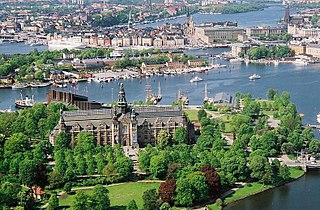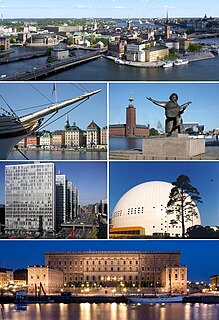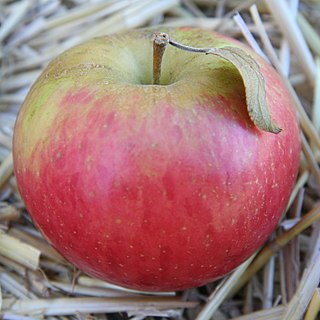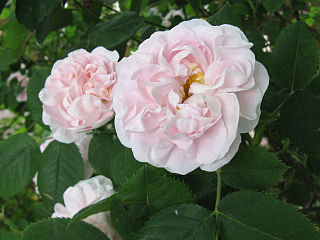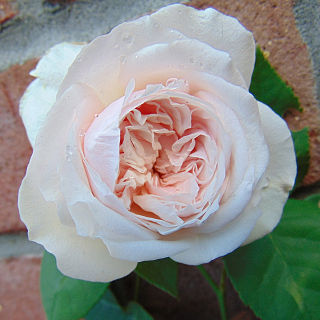
The pear tree and shrub are a species of genus Pyrus, in the family Rosaceae, bearing the pomaceous fruit of the same name. Several species of pear are valued for their edible fruit and juices while others are cultivated as trees.

Forest gardening is a low-maintenance sustainable plant-based food production and agroforestry system based on woodland ecosystems, incorporating fruit and nut trees, shrubs, herbs, vines and perennial vegetables which have yields directly useful to humans. Making use of companion planting, these can be intermixed to grow in a succession of layers, to build a woodland habitat.

The quince is the sole member of the genus Cydonia in the family Rosaceae. It is a deciduous tree that bears a pome fruit, similar in appearance to a pear, and bright golden-yellow when mature. Throughout history the cooked fruit has been used as food, but the tree is also grown for its attractive pale pink blossoms and other ornamental qualities.

Sissinghurst Castle Garden, at Sissinghurst in the Weald of Kent in England, was created by Vita Sackville-West, poet and writer, and her husband Harold Nicolson, author and diplomat. It is among the most famous gardens in England and is designated Grade I on Historic England's register of historic parks and gardens. It was bought by Sackville-West in 1930, and over the next thirty years, working with, and later succeeded by, a series of notable head gardeners, she and Nicolson transformed a farmstead of "squalor and slovenly disorder" into one of the world's most influential gardens. Following Sackville-West's death in 1962, the estate was gifted to the National Trust for Places of Historic Interest or Natural Beauty. It is one of the Trust's most popular properties, with nearly 200,000 visitors in 2017.

Rosa canina, commonly known as the dog rose, is a variable climbing, wild rose species native to Europe, northwest Africa, and western Asia.

Rosa rubiginosa is a species of rose native to Europe and western Asia.

A cooking apple, or culinary apple is an apple that is used primarily for cooking, as opposed to a dessert apple, which is eaten raw. Cooking apples are generally larger, and can be tarter than dessert varieties. Some varieties have a firm flesh that does not break down much when cooked. Culinary varieties with a high acid content produce froth when cooked, which is desirable for some recipes. Britain grows a large range of apples specifically for cooking. Worldwide, dual-purpose varieties are more widely grown.

Rosa gallica, the Gallic rose, French rose, or rose of Provins, is a species of flowering plant in the rose family, native to southern and central Europe eastwards to Turkey and the Caucasus. It was one of the first species of rose to be cultivated in central Europe.
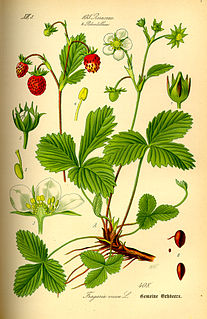
Fragaria vesca, commonly called wild strawberry, woodland strawberry, Alpine strawberry, Carpathian Strawberry, European strawberry, or fraisier des bois, is a perennial herbaceous plant in the rose family that grows naturally throughout much of the Northern Hemisphere, and that produces edible fruits.

The cottage garden is a distinct style that uses informal design, traditional materials, dense plantings, and a mixture of ornamental and edible plants. English in origin, it depends on grace and charm rather than grandeur and formal structure. Homely and functional gardens connected to working-class cottages go back centuries, but their stylized reinvention occurred in 1870s England, as a reaction to the more structured, rigorously maintained estate gardens with their formal designs and mass plantings of greenhouse annuals.

Syzygium jambos is a tree originating in Southeast Asia and occurring widely elsewhere, having been introduced as an ornamental and fruit tree.

Rosa × centifolia, the Provence rose or cabbage rose or Rose de Mai is a hybrid rose developed by Dutch rose breeders in the period between the 17th century and the 19th century, possibly earlier. Its parentage includes Rosa × damascena, but it may be a complex hybrid; its exact hereditary history is not well documented or fully investigated, but it now appears that this is not the "hundred-leaved" (centifolia) rose mentioned by Theophrastus and Pliny: "no unmistakable reference can be traced earlier than about 1580". The original plant was sterile, but a sport with single flowers appeared in 1769, from which various cultivars known as centifolia roses were developed, many of which are further hybrids. Other cultivars have appeared as further sports from these roses. Rosa × centifolia 'Muscosa' is a sport with a thick covering of resinous hairs on the flower buds, from which most "moss roses" are derived. Dwarf or miniature sports have been known for almost as long as the larger forms, including a miniature moss ross 'Moss de Meaux'.

Malus sylvestris, the European crab apple, is a species of the genus Malus, native to Europe. Its scientific name means "forest apple" and the truly wild tree has thorns.
Jean Pierre Vibert was a French rosarian.
La Louve is a private French contemporary garden, open to the public, in the town of Bonnieux in the Vaucluse Department of France. It was created beginning in 1986 by Nicole de Vésian, textile designer for the Paris fashion house of Hermès. It is classified by the French Ministry of Culture as one of the Notable Gardens of France.

Rosa 'Old Blush', also known as 'Parsons' Pink China', 'Old Blush China', 'Old China Monthly', is a China rose and has been cultivated in China for over a thousand years. It derives from Rosa chinensis, and is generally accepted as the first East Asian rose cultivar to reach Europe. It is recorded in Sweden in 1752 and in England before 1759, but was probably cultivated in China for several centuries. It is believed to be the rose which inspired the song The Last Rose of Summer by the Irish composer and poet Thomas Moore. It is also known as Parsons' Pink China, named after Mr Parson who introduced it commercially to the UK in 1793.

Garden roses are predominantly hybrid roses that are grown as ornamental plants in private or public gardens. They are one of the most popular and widely cultivated groups of flowering plants, especially in temperate climates. Numerous cultivars have been produced, especially over the last two centuries, though roses have been known in the garden for millennia beforehand. While most garden roses are grown for their flowers, some are also valued for other reasons, such as having ornamental fruit, providing ground cover, or for hedging.

Rosa × alba, the white rose of York, is a hybrid rose of unknown parentage that has been cultivated in Europe since ancient times. It may have originally been grown mainly for the sweet scent of the flowers, but is now also used as a winter-hardy garden shrub. Cultivated forms have white or pink flowers, and most have many petals. Hybrid cultivars have also been produced with red or yellow flowers.

Grappenhall Heys Walled Garden is a historic walled garden in Grappenhall, Warrington, Cheshire, England. The garden was built by Thomas Parr around 1830 as both a pleasure garden for relaxing strolls and as a kitchen garden to produce fruit, vegetables, and herbs. After a period of decline, the garden was restored first by English Partnerships and then by the local parish council in conjunction with the friends of the garden.

